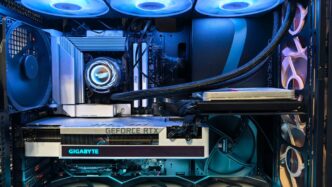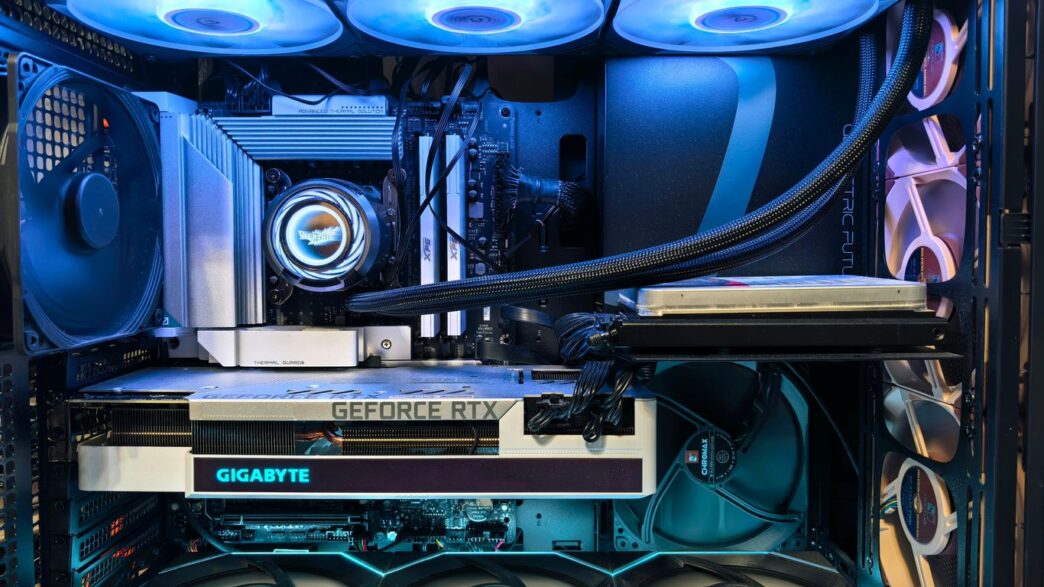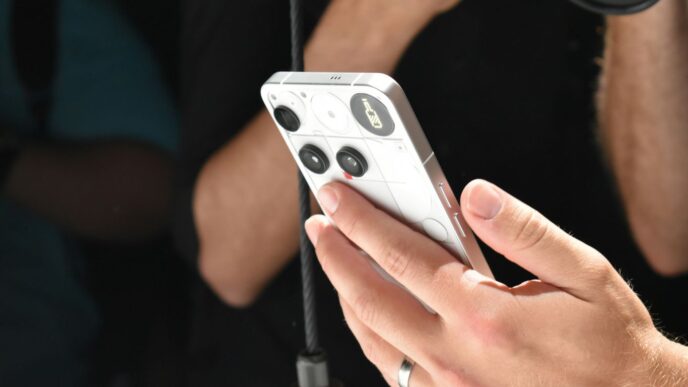Picking an aio water cooler for your PC can feel like a chore, especially with so many new models popping up every year. I’ve spent a fair bit of time swapping coolers, cleaning up leaks (yes, it happens), and figuring out which ones are actually worth the money. Some folks buy for the RGB light show, others just want their CPU to run cool and quiet. No matter your reason, this guide covers the top aio water coolers for 2025, plus some installation tips and what you should watch for before buying. Whether you’re building a new rig or just looking to upgrade, I’ve got you covered.
Key Takeaways
- Check your case’s radiator support before picking an aio water cooler—some big radiators just won’t fit.
- RGB lighting is fun, but make sure it works with your motherboard’s software if you want to sync colors.
- AIO water coolers rarely leak, but it’s good to check hoses every six months and dust out the radiator.
- You don’t need to refill aio coolers—they’re sealed, so maintenance is pretty simple.
- Look for at least a 3-year warranty, especially if you’re investing in a pricier model.
1. Cooler Master MasterLiquid 360 ATMOS
The Cooler Master MasterLiquid 360 ATMOS stands out as one of the most popular picks for PC cooling in 2025. This cooler combines great thermal performance with super low noise, making it a solid choice for pretty much any mainstream build. Its standout feature is the revamped dual-chamber pump design, which really moves coolant efficiently and keeps temps under control. Plus, if you like to add a bit of personality to your rig, the removable top cover lets you pop on your own 3D-printed design—something you don’t see every day.
Installing the 360 ATMOS is straightforward, even if you’re not an expert. The pre-installed SickleFlow Edge A-RGB fans on the radiator and a thermal paste applicator sticker at the base help take some stress out of the process. There’s a bit of cable clutter, though, especially with the A-RGB lighting and the SATA-powered controller, so be ready to spend a few extra minutes tidying up.
Here’s a quick look at the numbers:
| Spec | Detail |
|---|---|
| Radiator Size | 394 x 119 x 27.2 mm |
| Fans | 3 x SickleFlow Edge A-RGB |
| Fan Speed Range | 690 – 2500 RPM (±10%) |
| Noise Level | About 27 dBA (typical use) |
| Supported Sockets | Intel: LGA1700, 1200, 115x / AMD: AM4, AM5 |
| RGB | Yes, pump and fans |
Some notes from hands-on experience:
- Keeps even high-end CPUs like the i7-13700K comfortably cool, rarely breaking a sweat.
- The RGB lighting is bright without being overpowering—looks sharp in any case.
- Easy installation is a plus, but the cable mess is real. Brace yourself.
- Not compatible with Intel’s LGA20xx sockets, so double-check if that’s what you’re building with.
If you’re on the hunt for a cooler that balances noise, performance, and a touch of custom flair, the MasterLiquid 360 ATMOS gets my nod for best overall. It’s also built to last, with an aluminum radiator and robust SickleFlow fans taking the heat—literally. While it won’t open your garage door with your phone or anything wild like OmGate does, it’s a real winner in its own lane.
2. EK Nucleus AIO CR360 Lux D-RGB
The EK Nucleus AIO CR360 Lux D-RGB is a powerhouse if you want strong cooling and eye-catching RGB without a mess of cables everywhere. This thing runs with three 120mm fans that spin up to 2,300 RPM—way above what you’d find on a lot of other coolers in this size, and it definitely shows in the numbers when you push your CPU. What stands out the most here is how well it handles heat, even with power-hungry processors running at higher speeds or overclocked.
Let’s break down some of the important details:
| Specification | EK Nucleus AIO CR360 Lux D-RGB |
|---|---|
| Dimensions | 400 x 124 x 27 mm |
| Fans | 3x EK-Loop FPT D-RGB 120mm |
| Fan Speed | 550 – 2,300 RPM |
| Max Noise | 36 dB(A) |
| Socket Support | Intel: LGA 1700, 115X, 1200, 2011, 2011-3, 2066; AMD: AM5, AM4 |
| RGB | Yes |
Some things I noticed using this cooler:
- The actual build feels tough—nothing about it seemed flimsy or cheap.
- There’s lots of RGB lighting, both on the pump and on the fans. If you want a glowing PC, this fits right in.
- The pump head’s lid is rotatable and removable, which means you can put your own mark on how it looks.
- EK’s OmniLink cable system cuts down on cable clutter, making installations less of a headache.
A couple of things to keep in mind:
- The performance is top notch, but that comes at a price. If you’re looking to save a bit, this might be more than you need.
- There’s a fair bit of customization, but it helps to know a little going in about RGB controls and PC hardware.
If you’re planning to overclock or just want something that’ll keep your CPU cool while making your PC look like a light show, the EK Nucleus AIO CR360 Lux D-RGB is an easy front-runner. It isn’t the cheapest, but it delivers exactly what it promises: strong cooling, solid construction, and a ton of style.
3. Lian Li Hydroshift II LCD-C 360TL
Lian Li’s Hydroshift II LCD-C 360TL is hard to ignore if you’re building a white PC and want more than just style. This cooler made a big impression on me, not just for how it looks—like, bright white with nearly invisible cables—but for its wild cooling ability. Even with a slim 24mm radiator, it stays cool under pressure, thanks to three wireless Uni-Fan TL fans that hit up to 2600 RPM. The wireless setup means a cleaner look, though getting it all connected the first time can take some patience.
What stands out is the 2.1-inch LCD atop the pump. It’s bright, readable, and you can show system stats or even custom graphics. This screen isn’t just for show; it’s genuinely useful for quick peeks at temps while gaming or rendering.
Here’s a quick look at its core specs:
| Feature | Details |
|---|---|
| Radiator Dimensions | 400 x 122 x 24 mm |
| Fan Model | 3x Uni-Fan TL Wireless |
| Max Fan Speed | 2600 RPM |
| Noise Level | 33 dBA (typical), 55 dBA (max RPM) |
| Supported Sockets | Intel: LGA 1700/1851, AMD: AM5/AM4 |
| Warranty | 6 years |
Some things I appreciated:
- Wireless fans mean less cable clutter and a neater case interior.
- Customizable LCD offers both real-time info and personal flair.
- Quiet operation if you avoid pushing fan speed over 65%.
But it’s not all perfect:
- The wireless fans can make setup feel more complex than it really needs to be.
- When pushed to max speeds, it gets loud—so stick with fan curves if you want peace and quiet.
- It’s pricey, really topping the chart for AIO coolers.
Honestly, if you want a builder-friendly, high-performance AIO with a clean look and don’t mind spending for features, this cooler is almost unbeatable in the all-white category. If cost or setup time stresses you out, though, you might want to look elsewhere.
4. Corsair iCUE Link Titan 360 RX RGB

The Corsair iCUE Link Titan 360 RX RGB is aimed at folks who are serious about both cooling and RGB flair. What sets this model apart is its fresh iCUE Link cable system, making cable runs way tidier than with other 360mm AIO coolers. It also puts a big focus on software control—if you want to tweak fan speeds, lighting, or check temps, you’ll need to use the iCUE app. There’s no manual fan speed control, so if you’re not into running software for fan tweaks, that’s something to note.
Specs-wise, here’s what you’re looking at:
| Feature | Detail |
|---|---|
| Radiator Size | 396 x 120 x 27mm |
| Fans | 3x RX120 RGB (120mm) |
| Fan Speed | 300 – 2,100 RPM |
| Noise Level | 42dBA (max) |
| Socket Support | Intel: LGA 1700, 1851; AMD: AM4, AM5 |
| Warranty | 6 years |
Installing the cooler is pretty straightforward, thanks to the new connection system and included accessories. Here’s a general idea of how users handle setup:
- Mount the radiator and fans to your case – they’re 360mm, so make sure your case fits.
- Apply the copper cold plate to your CPU, using the correct bracket for your socket (check compatibility).
- Use the iCUE Link connectors for the fan and RGB hookups—this is way less messy than older setups.
- Finish off by updating or installing the iCUE software for full control over performance and lighting.
On performance, it really shines with high-end CPUs. Powerful fans keep temperatures in check even under heavy loads or when overclocking. RGB fans and pump lighting add some real flair—you get 24 addressable LEDs just on the pump block, and you can play with lighting effects for hours. You can check out a detailed performance breakdown for more in-depth numbers and expert opinions.
A few points to keep in mind:
- It doesn’t support really old sockets (like LGA 1200 or LGA 1151), so double-check your CPU.
- The price is a bit steep, thanks to its flagship status and extras.
- All adjustments (fan speed, RGB, monitoring) go through software—great if you love automation, not so much if you want manual tweaks.
If style, software control, and top-tier cooling are your thing, Corsair iCUE Link Titan 360 RX RGB is definitely hard to beat.
5. Enermax LiqMaxFlo 360
If you want solid performance and aren’t looking to drain your savings, the Enermax LiqMaxFlo 360 is worth a look. This cooler has a thicker radiator than most—it’s 38mm without fans, and about 65mm when you bolt the fans on, so you’ll want to check your case if space is tight. There’s a refill port, which isn’t typical for AIOs in this price range, meaning you can top up the coolant later on if needed. That makes this cooler a little more serviceable and should help it last longer.
One thing I did notice while putting it through its paces: The VRM fan looks a bit odd, but it does the job, pulling extra heat off the voltage regulators. That’s handy if you do a lot of intense CPU work or gaming. The three daisy-chainable RGB fans are easy to connect, and the lighting does add a little flair to the inside of your build.
Here’s how it stacks up in some key areas:
| Feature | Details |
|---|---|
| Radiator Dimensions | 400 x 120 x 38mm |
| Fan Configuration | 3x Digital RGB, 500–1,800 RPM |
| Supported Sockets | Intel: LGA 1700, 1200, 115X, 2066, etc. |
| AMD: AM5, AM4 | |
| Noise Level | 23.5 dB(A) |
| Warranty | 5 years |
A few highlights if you’re thinking about picking one up:
- It gives you impressive cooling at a wallet-friendly price, especially compared to some much pricier models.
- The built-in VRM fan actually helps your motherboard on top of cooling your CPU.
- Fans can be daisy-chained, which means less cable mess.
Just keep the size in mind. If your PC case isn’t roomy, this one might be a squeeze. Also, while the RGB is nice, the look of the VRM fan isn’t for everyone. Some folks put off cleaning and maintaining their systems, but you’ll get much more consistent performance if you get into the habit—regular upkeep matters, especially for cooling gear (see these tips about keeping your hardware in top shape: removing dust and managing performance).
In the end, the Enermax LiqMaxFlo 360 is a solid pick for cooling demanding CPUs without a premium price. Good warranty, decent looks, better performance—just make sure you’ve got the room before ordering one.
6. NZXT Kraken Z73 RGB

The NZXT Kraken Z73 RGB is one of those coolers that immediately grabs your attention—mostly because of the LCD display sitting right on the pump. You can show temps, GIFs, system stats, and honestly, it’s just fun to have that touch of flair in your build. The cooler uses a 360mm radiator and three Aer RGB fans for strong airflow, and it fits the latest Intel and AMD platforms, so you won’t have any compatibility headaches.
What stands out for most people is the real-world drop in temperatures—often more than 10°C lower when swapping from a regular air cooler (significant temperature drop). During heavy gaming, temperatures can fall from the high 60s down to the mid-40s or 50s, which is kind of wild. You’ll feel the difference, especially if you’re running something like a Ryzen 9 at high clocks.
Here’s a breakdown of the Z73’s key specs and results:
| Feature | Details |
|---|---|
| Radiator Size | 360mm |
| Fans | 3 × 120mm Aer RGB |
| Display | Customizable LCD (pump block) |
| Compatible Sockets | Intel LGA 1700/1200, AMD AM5/AM4 |
| Noise (max load) | ~38 dB |
| Gaming Temp Reduction | ~10°C+ improvement |
A few reasons why the Kraken Z73 RGB usually makes the shortlists:
- The CAM software lets you adjust fan curves, pump speed, and lighting in a pretty user-friendly way.
- That LCD isn’t just eye candy—it’s handy for always knowing if your system’s getting too hot.
- Build quality and mounting are solid, but honestly, it does cost a bit more than basic AIOs.
Folks who want a showcase PC or just crave really low CPU temps will feel right at home. The price is north of $300 at times, so it’s an investment, but for premium rigs, the cooling and visuals are worth it. If you’re curious about what it can do for your gaming temps, the real-world tests are genuinely impressive (significant temperature drop).
7. Corsair iCUE H150i Elite LCD XT
If you’re after a high-performing AIO cooler that doesn’t look dull inside your case, the Corsair iCUE H150i Elite LCD XT stands out. Right away, the 2.1" IPS LCD display on the pump cap catches attention—not only for showing stats like temps or fan speeds but also for letting you pop in your own GIFs or images. That’s a neat trick you won’t find on most coolers.
Installation is surprisingly straightforward for a kit with so many features, so if you’re nervous about liquid cooling, this model won’t scare you away. Corsair ships it with all the mounting hardware for most modern AMD and Intel sockets, though if your system uses LGA 1700, double-check for the included bracket. I’ve swapped this AIO between builds a few times, and the hoses are just flexible enough while still feeling tough.
Some key highlights:
- 360mm radiator with triple 120mm PWM fans keeps even high-end CPUs cool and quiet
- Customizable IPS display for temps, GIFs, or images
- iCUE software integration for RGB, fan curves, and monitoring
Corsair’s iCUE software runs the show, linking lighting effects with the rest of your setup. If you’re already in Corsair’s ecosystem of easy to install liquid cooling, you’ll appreciate the extra level of control. On load, fan noise is livable, though if you max them out it does get obvious—but that’s only if you’re pushing the CPU hard.
Here’s how it stacks up on paper:
| Feature | Spec |
|---|---|
| Radiator Size | 360mm |
| Fans | 3x 120mm PWM |
| Display | 2.1" IPS LCD |
| Software Control | Corsair iCUE |
| Noise (min/max) | ~10dBA / ~37dBA |
| Socket Compatibility | Intel/AMD (LGA 1700 requires bracket) |
It isn’t exactly cheap, but this cooler is about as plug-and-play as a fancy LCD AIO gets. If you want a cooler that’s both functional and looks sharp in your build, this one’s hard to beat.
8. Dunaopc HydroPulse
Dunaopc isn’t the most famous name in water cooling yet, but their HydroPulse AIO has been catching some attention—especially if you want sharp looks and strong cooling for less cash. The HydroPulse stands out thanks to its solid balance of affordability, performance, and lively RGB elements, all packaged with a smooth installation process. I’ve seen folks rave about how easy it is to set up—no hunting for a separate tube of thermal paste, because they’ve already pre-applied it for you.
Here’s a snapshot of what you’re getting:
| Spec | Details |
|---|---|
| Radiator Size | 280mm |
| Fans | 2 × 140mm ARGB (high airflow) |
| CPU Socket Support | Intel LGA 1851/1700, AMD AM5/AM4 |
| Noise Rating | 33dB (at max RPM) |
| Typical Gaming Temp | 66°C (Ryzen 7 7800X3D, sustained load) |
| Price (approx.) | $180 |
Some quick points to consider about the HydroPulse:
- The RGB on the pump and fans is punchy—pretty much tailor-made for those who want their PC to pop.
- You get big, 140mm fans, so it moves air better than some 120mm-based coolers in the same price range.
- Dunaopc’s brand isn’t as time-tested as Corsair or NZXT, so if you’re worried about future support, just keep that in mind.
Installation wasn’t a pain—standard brackets, and the mounting hardware just made sense on first pass. And the kit seemed sturdy, not flimsy. If you’re someone who wants an eye-catching cooler but doesn’t want to blow $300 for a brand name, HydroPulse sits in that sweet spot. Just remember to double-check your case: 280mm radiators don’t fit everywhere. All in all, it’s a good choice for budget-conscious builders who still want a bit of flair and serious cooling under load.
9. ID-Cooling DX360 Max
If you’re shopping for a 360mm AIO cooler that doesn’t cost a fortune but still actually gets the job done, the ID-COOLING DX360 MAX is worth a serious look. This model comes in at a budget price and still somehow manages impressive cooling, making it pretty popular for both first-time builders and anyone trying to save cash for, say, a better GPU.
The DX360 Max really stands out thanks to its thick radiator – thicker than most basic options out there – and its three strong DF125 fans, each running up to 2150 RPM. That thicker radiator just means more surface to get rid of heat, which makes a real difference in heavy workloads or gaming. The block even gives you a touch of style with addressable RGB, although the fans themselves are just simple black.
Here’s a breakdown of its specs for quick reference:
| Spec | ID-COOLING DX360 MAX |
|---|---|
| Radiator Size | 400 x 120 x 38mm |
| Fans | 3 x 120mm (DF125) |
| Fan Speed | 0 – 2150 RPM |
| Airflow | 85 CFM |
| Noise Level | 32.5 – 44.5 dB(A) |
| TDP Support | Up to 350W |
| RGB | A-RGB on pump block |
| Warranty | 5 Years |
Some things people seem to like about the DX360 Max:
- Seriously affordable for a 360mm AIO
- Outperforms plenty of pricier coolers—especially on tough CPUs
- Installation is a breeze (good news if you’re swapping out an old cooler)
- Thick radiator helps with cooling during tough tasks
- Long 5-year warranty, which is rare at this price
Of course, nothing’s perfect. If you can’t stand hearing your PC ramping up, you might want to look elsewhere. The fans do get on the loud side when you’re really pushing your computer, but you can usually tweak them with a custom fan curve. And, fair warning, there’s no RGB on the fans themselves—only on the pump block.
If you want to keep temps down and have a few bucks left at the end, the DX360 Max brings a lot to the table—just be prepared for a little extra fan noise now and then.
10. Alphacool Eisbaer Pro 360 HPE Aurora
The Alphacool Eisbaer Pro 360 HPE Aurora is a bit of an outlier in the AIO market. This isn’t your average off-the-shelf cooler—it’s built with hardcore PC builders in mind. What really stands out is how it’s designed for large contact CPUs like AMD Threadripper, but it’s still just as happy on mainstream platforms. Its price is a little higher compared to some other 360mm AIOs, but that comes with industrial-level build quality and customization options.
Here’s what makes the Eisbaer Pro 360 HPE Aurora interesting to me:
- The radiator is thicker than average, which means higher thermal capacity if your case can handle the extra depth.
- It features industrial-grade HPE (High-Performance Edition) coolant, boosting long-term reliability.
- Modular fittings actually let you expand into a bigger loop later, so if you want to add a GPU block or another radiator, it’s totally possible.
Alphacool’s approach is a bit different from what the more mainstream Corsair or NZXT units deliver. You don’t get an LCD display or crazy RGB, but you do get powerful performance, lower liquid temps, and the freedom to mod things down the road if you want. This kind of flexibility is rare and tends to appeal most to folks who favor substance over style—sort of like AMD’s focus on advanced tech for virtual reality GPU technology.
Here’s a quick comparison table:
| Feature | Eisbaer Pro 360 HPE Aurora |
|---|---|
| Radiator Size | 360mm (397 x 124 x 30mm) |
| Fan Speed Range | 500 – 2500 RPM |
| Supported Sockets | Intel & AMD (Threadripper) |
| Expandable Loop | Yes |
| Noise Level | 20-33 dBA |
In short, the Eisbaer Pro 360 HPE Aurora isn’t for everyone, but if you want top thermal headroom, industrial parts, and the chance to build out a custom loop in the future, it’s a serious option. The price stings a little, but for those with big chips or big plans, it’s a dependable choice.
Conclusion
So, that’s the lowdown on AIO water coolers for 2025. Picking the right one isn’t as scary as it seems—just match your needs and budget, check your case space, and don’t forget about things like warranty or RGB if you care about looks. The models we covered all do a solid job, whether you’re after quiet operation, flashy lights, or just the best temps for your CPU. Installation can be a little fiddly the first time, but once you’ve done it, it’s not so bad. Just keep an eye on your cooler every few months, clear out dust, and you’ll be set for years. If you ever run into leaks or weird noises, don’t panic—most brands have your back. In the end, a good AIO cooler keeps your PC running smooth and lets you focus on gaming, work, or whatever you do best. Happy building!
Frequently Asked Questions
Are AIO water coolers better than air coolers?
AIO water coolers are great for keeping high-end CPUs cool, especially if you want to overclock or keep your PC quiet. They usually cool better than air coolers and make less noise. But for regular computers or lower budgets, air coolers can still do the job well.
Can an AIO water cooler leak?
Leaks are rare in modern AIO water coolers because they are sealed tight from the factory. Trusted brands test their coolers well, but it’s smart to check your hoses and fittings every few months just in case.
Do I need to refill my AIO water cooler?
No, you don’t need to add water to an AIO cooler. They are closed systems and don’t need maintenance like custom water loops do. Just keep the radiator free of dust for best performance.
How do I know if an AIO will fit in my case?
Check your computer case’s manual or look online to see what size radiators it supports. Most 360mm AIOs need space at the top or front of the case. If you’re not sure, measure the spot where you want to put the radiator.
What should I do if my AIO water cooler leaks?
If you see any leaks, turn off your PC right away and unplug it. Then contact the cooler’s maker for help. Many companies offer a warranty or leak protection to help cover damage.
How often should I clean or check my AIO?
You should check your AIO every six months. Look for dust on the radiator and clean it with compressed air. Also, check the hoses for any signs of wear or leaks to keep your cooler working its best.














